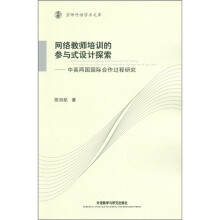Abstract
Acknowledgements
List of Tables
List of Figures
Key Acronyms
Chapter 1 Introduction
1.1 ABOUT THE RESEARCH
1.2 DISTANCE EDUCATION
1.2.1 A brief history of distance education globally
1.2.2 History of distance education in China
1.2.3 Teachers and teacher training in distance education
1.3 THE STUDY
1.3.1 The context of the study
1.3.2 The purpose of the study
1.3.3 The significance of the study
1.4 0VERVIEW OF THE BOOK
Chapter 2 Literature Review
2.1 INTRODUCTION
2.2 PARTICIPATORY DESIGN
2.2.1 Why PD?
2.2.2 Challenges for PD
2.2.3 Implementation of PD
2.2.3. 1 PD in software design
2.2.3.2 PD in education
2.2.3.3 PD in e-learning
2.2.4 Influential factors of PD
2.2.4.1 Collaboration and cooperation in team work
2.2.4.2 Types of teams and team roles
2.2.4.3 Team work strategies
2.2.4.4 Culture and team work
2.2.4.5 Intercultural communication competence and team work
2.2.5 Summary
2.3 E-TUTOR TRAINING
2.3.1 e-Tutors as teachers
2.3.1.1 Theory basis for teacher education
2.3.1.2 Models in teacher education
2.3.1.3 Theories and models for teacher education in China
2.3. I .4 Distance teacher education
2.3.2 e-Tutors and e-learning
2.3.2. 1 e-Learning
2.3.2.2 e-Learning design: process and pedagogy
2.3.2.3 e-Learning in teacher education
2.3.3 e-Tutor training
2.3.3. 1 Roles and competences of e-tutors
2.3.3.2 e- Tutor training models and pedagogies
2.3.4 Culture and pedagogy
2.3.4.1 Authority and autonomy
2.3.4.2 Harmony and criticality
2.3.4.3 Collectivism and individualism
2.4 THE THEORETICAL FRAMEWORK
2.5 SUMMARY
Chapter 3 Research Methodology
Chapter 4 Understanding the Context
Chapter 5 The PD Process and the Influential Factors
Chapter 6 e-Tutor Training Pedagogy from PD Process
Chapter 7 Conclusions
References

 缺书网
缺书网 扫码进群
扫码进群



